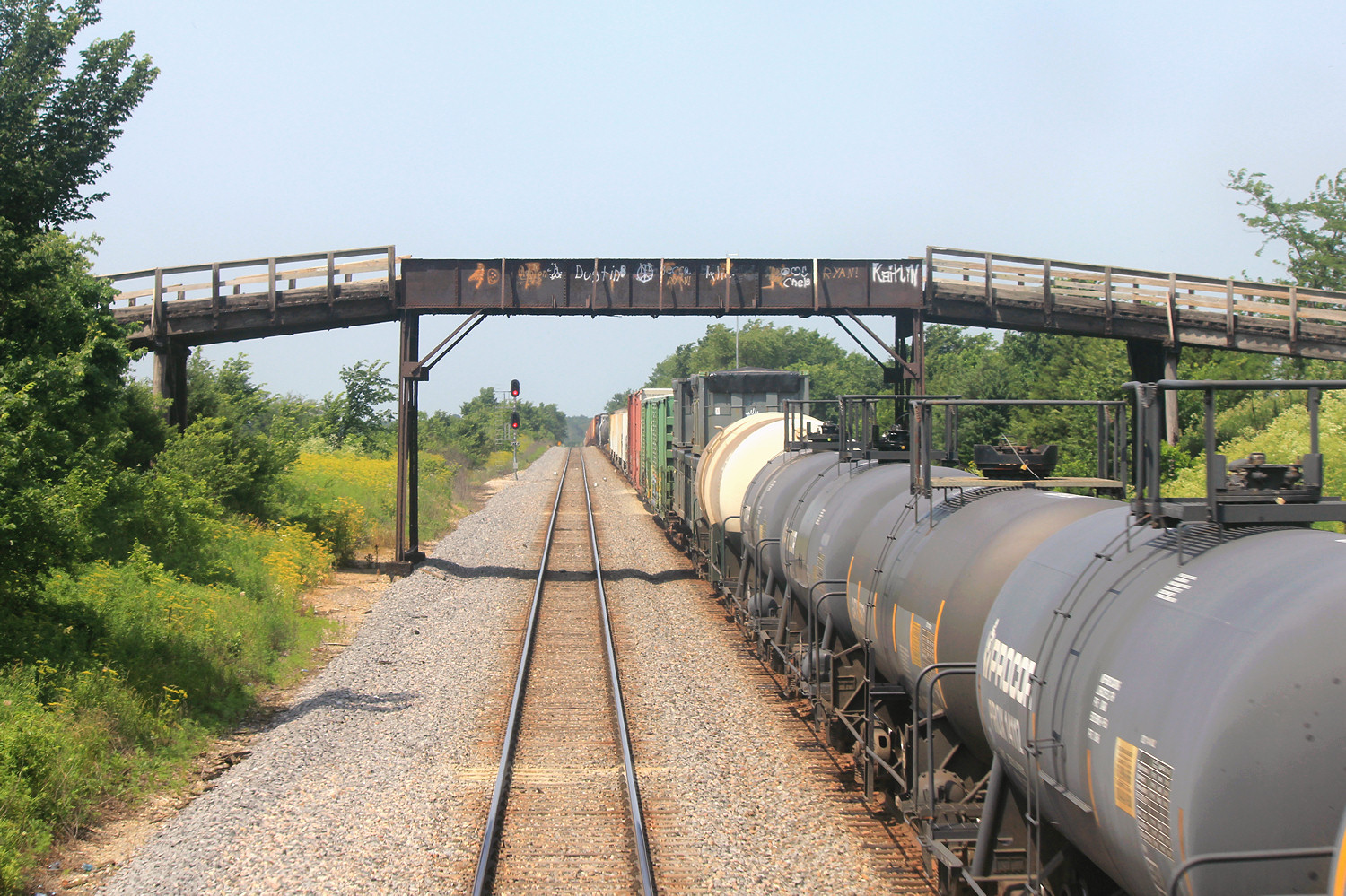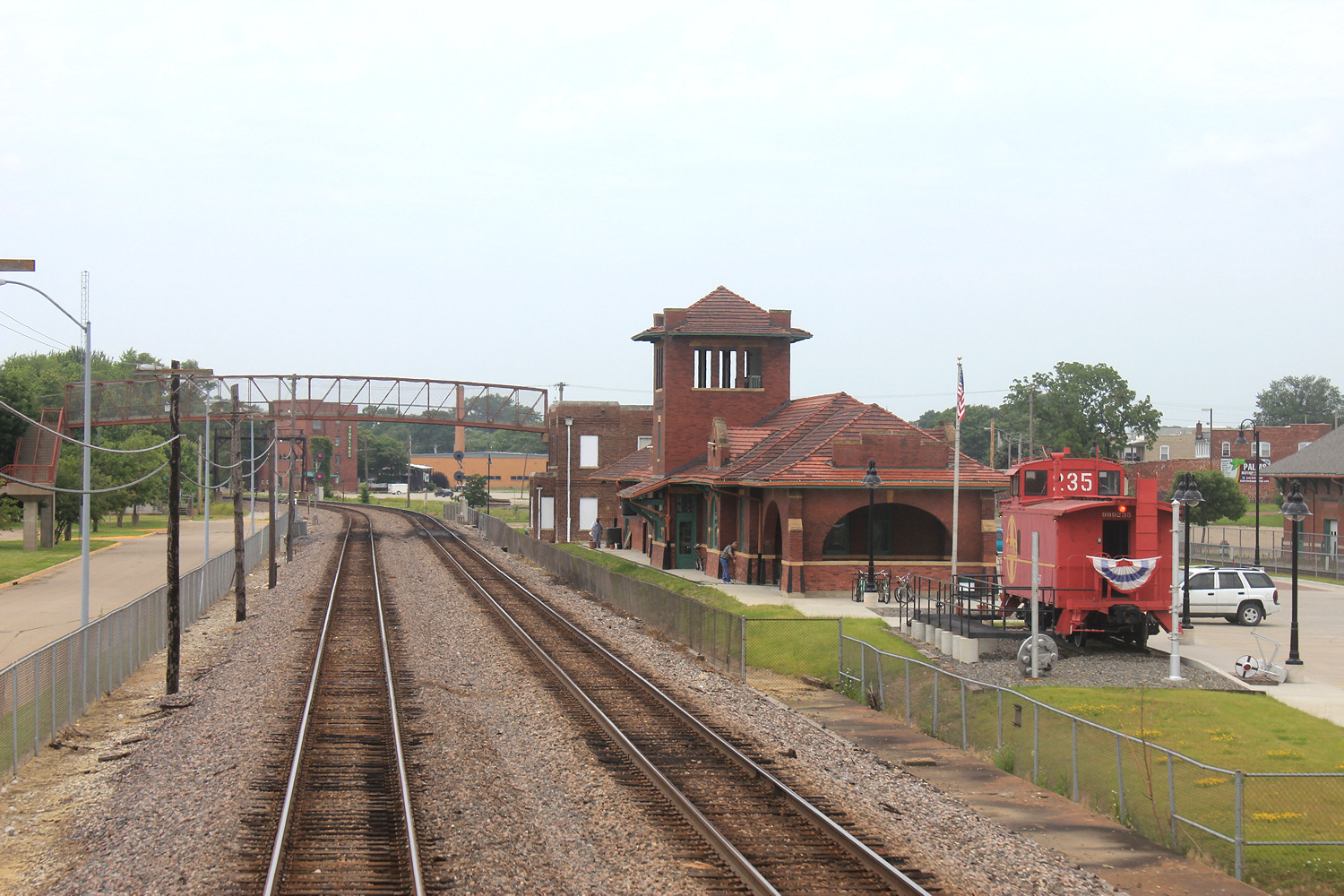You can find all the photos from this set by clicking here and then scrolling about a third of the way down. For those who didn't notice the first part of the set was covered in my post from last week.
Right off the bat we encounter an example of the sort of ATSF signal infrastructure that BNSF should reusing more often instead of scrapping. Oh, notice that we are back in ATS territory with a 90mph speed limit...for about 6 miles.
Near the town of Orrick we are passed by a westbound mixed freight train with C44-9W #4108 in the #2 slot.
At CA JCT we encounter the NS Kansas City District. Between here and WB JCT the line is operated under joint NS-BNSF authority with NS maintaining track #3 in the three track segment and track #2 in the two track segment. The NS line was a former Wabash route and at some point in the past the Wabash teamed up with the ATSF to save a bit of money where their main lines ran parallel to eachother.
Former ATSF station at Henrietta, MO.

At HARDIN the third NS maintained track is folded into the two track ATSF main. All tracks between WB and CA are dispatched by BNSF even if NS maintains them. You can see in this overhead view how the old Wabash main was tied into the ATSF main west of town and then how east of town the two-track line splits with one track using the Wabash alignment and the other track using the ATSF alignment. In this photo you can see the NS signal on track 2 and the BNSF signal on track 1 at HARDIN.
Ray Carroll Co-op GP9 #6550 hanging out at Norbourne, MO. This unit switches a nearby grain elevator.
The joint track area is fitted with both BNSF and NS mileposts. Here we see BNSF milepost 395 (to Chicago) at the NS MP 219 automatic signal.
The re-signaling crews were out in force at WB JCT because apparently we can have nice things.
A 4-GE lashup at the front of a doublestack train races towards the clear signal at WB JCT.
Former ATSF station at Carrollton, MO with the end of the previous intermodal train passing through the Wakenda Creek truss bridge near the MP 386 automatic signal. Note that we are back in ATS territory and that means 90mph speeds all the way to Fort Madison.
A whole lot of GE units on the wide RoW section near Bosworth. Due to a temporary speed restriction my own trains P42's let out a belch of soot as they accelerated back up to track speed.
Of course the entire line is being re-signaled with the interlockings lingering on a bit longer than the automatics. Looks like I just missed out on catching some of the former ATSF automatic signal bridges in service.
Pair of GE's running elephant style with another intermodal train at Tripplet, MO.
The old yard at Marceline, MO, isn't used much any more, but still retains an old concrete ATSF coaling tower.
Former ATSF station and division offices at Marceline. The subdivision is named for this location which is now barely a blip on the railroad map. Places like Marceline were marginalized when dieselization and other railroad productivity improvements increased the distance that a single locomotive and train crew could take a train in a day. instead of having to stop for coal, water and new meat, the trains now make the run from Ft Madison straight through to Kansas City without needing any of those.
Marceline is best known for being the boyhood home down of evil cult leader Walt Disney and the station has been converted into a Disney themed worship center.
West of Marceline I encountered some ATSF searchlights that appear to have escaped the resignaling project.
And a few more retreated ATSF signal bridges. Note the ATS induction shoes. IIATS is in service in both directions on both tracks for the entire distance.
The only Amtrak station stop in rural Missouri is at La Plata. Why this was picked over Marceline I do not know. Possibility the proximity to US 63.
This route had more than its fair share of old time single lane road overpasses. The ATSF was once clearly flush with cash to be able to afford luxuries such as grade separation.
Overtaking BNSF C44-10W #7920 at Baring, MO. #7920 was the last in a 721 unit order of new Tier III compliant C44-10W's.
Our train was causing some congesting as C44-9W and a friend are held up at EAST BARING interlocking waiting for us to clear up so it can head westbound and unblock #7920.
Rail replacement crew east of Baring, MO.
Passing yet another intermodal train at Wyaconda not sure if we were overtaking or passing.
Video of the same train showing a pair of additional C44-10W engines on the other end. Our train was travelling at ~90mph at this point and you can see us round a curve with an 85mph speed restriction just west of the MP 268 automatic signals.
Crossing the Des Moines River into Iowa at MP 252.
A taste of foreign power at Argyle, IA with Union Pacific AC4400 #5564 and SD70M #4153. This was soon followed by another.
BNSF freight locomotives in Ft Madison yard with an old BN painted tank car nearby.
Ft Madison station with Superliner I #31008. Automatic signal #235 marked the end of ATS territory for the entire trip.
Another string of BNSF engine ready to lead a doublestack train eastbound.
Departing Ft Madison with a railfan taking video from the end of the platform.
Passing the old ATSF Ft Madison station which is slated to become the new Amtrak Ft Madison station. The station marks the end of the Marceline Sub and the start of the Chillicothe Sub.
Crossing the Mississippi River on the world's longest double deck swing span.
BNSF C44-9W #4807 approaching NOTIA interlocking with a unit grain train in tow.
On the rear was ES44C4 #6528.
Another ES44C4 at on the rear of an intermodal train this time.
Station and interlocking at Stronghurst. This section of the former ATSF main had been re-signaled just before BNSF went on its current tear and was when the railroad bothered to reuse hardware with life still remaining on it. Note the clear indication displaying on the track 1 searchlight mast.
Well that's it for the ATSF main line. Next week I will bring you a new perspective from the dash along the former CB&Q 3 Track racetrack into Chicago's Union Station.




































No comments:
Post a Comment